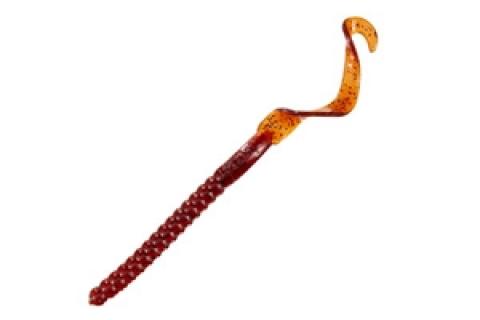
No series on classic fishing lures that have stood the test of time could be complete without including the plastic worm. Although a patent had actually been secured for a rubber artificial worm as early as 1877, that product was so stiff and unproductive that it never went anywhere. Certainly other people tried to make fake worms after that, but it wasn't until the middle of the Twentieth Century that a truly effective artificial worm was created.
 |
| The plastic worm can now be found in a variety of styles and sizes. |
The person who did it was Nick Creme, of Akron, Ohio. The year was 1949. His creation was one of the simplest, but also greatest bass fishing lures of all time.
While most lures in that day were made of wood, in the form of plugs, or metal, for spoons and spinners, Creme felt something more slithery and soft with a more subtle motion in the water might look more realistic and fool some of those educated bass that had "seen it all." He knew natural baits would often outscore artificials. And he knew that plain vanilla nightcrawlers had caught bass for years, so he decided to melt vinyl and pour it into a mold to create an artificial worm. He used a real nightcrawler to make the mold and added color and oils for scent appeal.
The result was the Wiggle Worm, a 6-inch long worm first marketed in 1951 and still sold today under its newer name, the Scoundrel. Creme's lure caught largemouths like crazy and soon became a standard in every bass angler's tackle box. Other companies produced their versions, but the most notable enhancement came when Tom Mann introduced his Jelly Worm in 1967, with its softer, slippery feel, translucent look and wide variety of colors.
Plastic worms have won more bass tournaments than any other offering, and they are still immensely popular today among both pros and recreational anglers alike.
And they are offered in an incredible array of styles and sizes. There are worms from two inches long for panfish and trout to ten inches for jumbo bass. There are worms with curly tails, skinny worms, fat worms, Wacky Worms, flavor-fortified worms, salt-impregnated worms, worms with rattles and about everything else you can imagine. But they are all very similar to the original Nick Creme invention. Some are pre-rigged with multiple hooks, but most popular with expert fishermen are the Texas and Carolina-rigging methods with a single hook. The reason this system works is because a bass normally bites the worm towards the front or head as it swims through the water, inhaling the front-rigged hook.
Tactics
Rig Texas-style for fishing in heavy brush where snags are a problem, Carolina-style for open water or skittish fish. Cast and retrieve slowly so the worm inches along, or use the tried-and-proved lift-and-drop method. Make sure you feel bottom contact throughout the retrieve.
Go with 4-inch worms for river smallmouths and finicky bass, 6-8 inch worms for all-around fishing, 10-inch worms for summer and when huge bass are present. Also try lizards in spring and crayfish in summer and fall. Plastic worms aren't just for bass, though. I've caught plenty of whopper panfish on scaled down versions as well as some handsome pike, pickerel, trout and too many saltwater species to count.
- 5219 views

